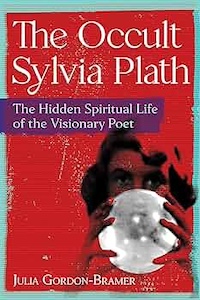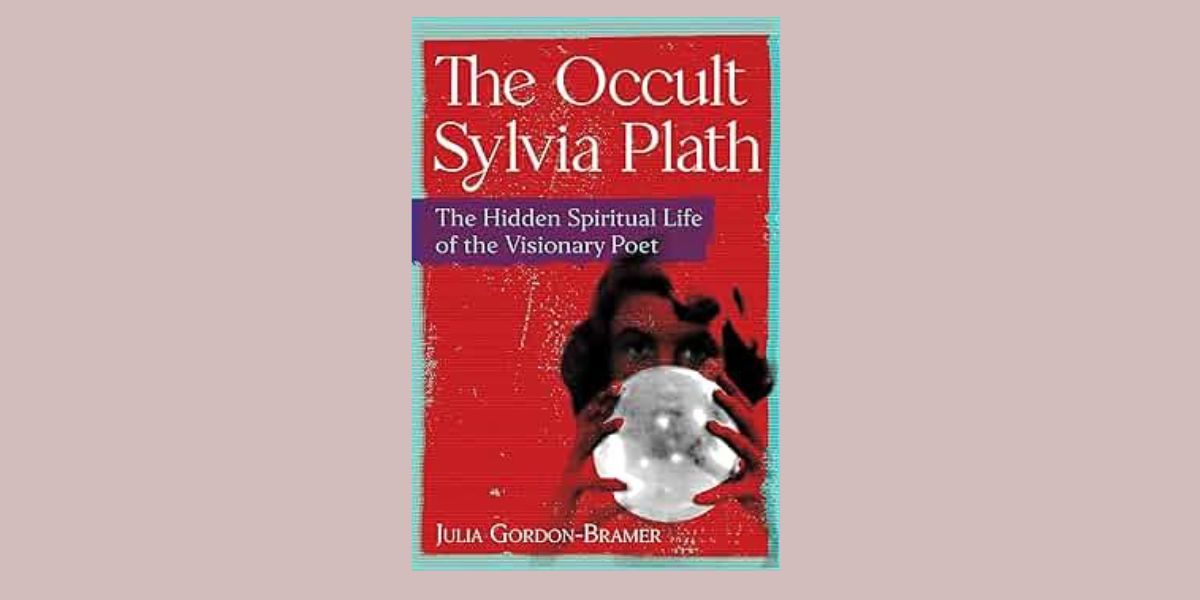
The Occult Sylvia Plath: The Hidden Spiritual Life of the Visionary Poet, by Julia Gordon-Bramer
Destiny Books, 1644118629, 416 pages, May 2024
Poetry is a form of spellcasting, and Sylvia Plath (1932-1963) continues to captivate readers as her following grows through BookTok. Plath was best known for her confessional poetry and her semi-autobiographical novel, The Bell Jar, which she published just before her suicide under the pen name Victoria Lucas. Beyond her iconic status as a tragic heroine, Plath was fascinated with the occult. Biographers have often overlooked this aspect, but Plath scholar Julia Gordon-Bramer delves into this profound influence in her book The Occult Sylvia Plath: The Hidden Spiritual Life of the Visionary Poet. A poet and tarot reader herself, Gordon-Bramer unveils Plath’s fascination with Qabalah, Jungian alchemy, astrology, tarot, and even the Ouija board, revealing the sorcery woven into her writing.
I first encountered Sylvia Plath in an undergrad poetry class. The lecture focused on lurid biographical details, reducing her to a tortured poet with daddy issues, who was driven to suicide by her husband’s infidelity. Dissecting poems like “Daddy” and “Lady Lazarus,” which were laced with disturbing holocaust symbolism, made my skin crawl. Reading her poetry was like eating wild honey straight from a swarming hive. The honeycomb was blackened with dust and mold spores, and dead bees were trapped in dark, viscous amber. There was a vague sense of danger, as if internalizing her words might infect me with the same madness that drove her to end her own life.
She instantly became one of my favorite poets. Plath gave me permission to harvest radioactive material from the dregs of my soul, to be raw and unfiltered in my writing. Nothing was off limits. While this provocative introduction to her poetry inspired me and granted me greater creative freedom, I now realize that I was so spellbound by her mythical image that I lost sight of the transcendent nature of her work.
In The Occult Sylvia Plath, Plath scholar Julia Gordon-Bramer dismantles the oversimplification of Plath’s poetry as confessional, arguing that previous biographers have overlooked the influence of world events, Plath’s social circle, and most importantly, her fascination with the occult. Informed by over fifteen years of research, Gordon-Bramer deep dives into letters, journals, and even marginalia in Plath’s personal library, weaving together a web of occult connections that resonated throughout Plath’s oeuvre. Gordon-Bramer’s compelling insights have enriched my own appreciation of Plath’s poetry, as viewed through the kaleidoscopic lens of her spiritual journey.
“For over fifty years, Sylvia Plath’s story was controlled and severely restricted by the estates of Sylvia Plath and Ted Hughes,” says Gordon-Bramer. “Until recently, editors of Plath’s and Hughes’s published letters downplayed their interests in the occult.”1 It turns out that the tortured poet facade I had idolized as an undergrad creative writing student was carefully curated for mass appeal. “Even many of Plath’s better photos were not published, possibly in an effort to cast her as a dowdier, more depressive poet,”2 Gordon-Bramer says. In this book, she hopes “to break the world from the habit of reading Plath’s work solely through the lens of autobiography.”3
Each chapter is named after the title of a Plath poem. In “April Aubade,” Gordon-Bramer humanizes Sylvia’s father, Otto Plath, a German immigrant who, during World War I, was flagged by the FBI as “an ‘alien enemy’ for having pro-German sympathies and expressing a desire to return to his homeland one day.”4 Otto was in fact a pacifist and a victim of the persecution that many German Americans faced during those troubled times. “Becoming a young man, alone with no family and few friends in a foreign country, Otto Plath endured it all, probably not without significant emotional damage,”5 Gordon-Bramer says.
Knowing these details about Otto Plath casts “Daddy” in a new light. The poem feels both intensely personal and transcendent. As Plath exorcizes the ghost of her German father and identifies with the Jews, she also seems to be grappling with a shared sense of horror for the atrocities of the Holocaust. The pain in this poem is visceral, and with the added context of her father’s struggles as an immigrant, the final stanza stings with deeper resonance:
“There’s a stake in your fat black heart/And the villagers never liked you./They are dancing and stamping on you./They always knew it was you./Daddy, daddy, you bastard, I’m through.”6
Plath’s rage transcends the personal, becoming a powerful voice for collective trauma.
Bees are prevalent in Sylvia Plath’s poetry, and she inherited her fascination with them from her father, who earned the childhood nickname “Bee King” because he had a talent for “charming bees to steal their honey.”7 This passion continued into adulthood, as he studied and cared for bee colonies at the Arnold Arboretum in Boston, Massachusetts from 1922 to 1928. Gordon-Bramer highlights the occult significance of bees, revealing that Otto was initiated into Freemasonry in 1928 and bees are a potent Freemason symbol, representing the alchemical transformation of pollen into honey through the hive’s collective efforts. Gordon-Bramer also notes that Sylvia’s mother, whose name, Aurelia, means “golden”8 in Latin, wrote her master’s thesis on the famed alchemist Paracelsus, which Otto read and admired.
Sylvia Plath was a Scorpio, born on October 27, 1932, under the looming shadow of the Great Depression. Gordon-Bramer explores how Sylvia’s early life was shaped by both environmental influences and her parents’ personalities. Her father Otto, an authoritarian Aries, exhibited a demanding and emotionally distant parenting style, while her mother Aurelia, a possessive Taurus, could be both smothering and invasive. The cross-pollination of Sylvia’s parents produced a precocious child who sought love and approval through academic achievement and perfectionism.
“Because of his ill health, Otto never hugged or kissed his family for fear that he might spread disease,” Gordon-Bramer says. “Perhaps, for reasons he thought were kind and sensible in those times before antibiotics, he kept his distance, rarely talked to or played with his children, and quietly stayed in his room, already existing like a ghost.”9
Otto’s death could have been averted if he had sought medical treatment sooner. In a vain desire to preserve an image of masculine strength and independence, he stubbornly soldiered through the pain, refusing to see a doctor until it was too late. He was suffering from pneumonia and advanced diabetes, and his left leg had to be amputated due to a gruesome gangrene infection that horrified his daughter, plaguing her with nightmares even towards the end of her own life. Otto died of a lung embolism on November 5th, 1940, during World War II. Sylvia was only eight years old.
The name Otto means “wealthy,” but he failed to leave behind an inheritance that would sustain his family after his premature death.10] However, he bequeathed a Plutonian wealth of emotions to Sylvia, which she excavated at great length to fuel her artistic creativity. She mined a wide variety of emotional ores, from gilded veins of pride in his accomplishments as a “self-made man,” to the ancestral iron of blood and war she so eloquently smelted into poetry.11
In the summer following Otto’s death, the precocious eight-year-old Sylvia published her first poem in the Boston Traveler. Her father’s passing was a catalyst for her pursuit of literary fame, and the lingering influence of his high standards had conditioned her to seek external validation through artistic achievement and academic excellence.
Otto’s death also initiated a profound spiritual crisis for Sylvia. Feeling abandoned by her father and resentful towards God, she declared, “I’ll never speak to God again.”12 Despite flirting with atheism, Sylvia was fascinated with religion and spirituality, and her personal beliefs were influenced by a blend of Unitarianism and paganism, leading her to identify as a “pagan sunworshiper”13 in her college years.
In 1953, after a month in New York City working as a guest editor at the magazine Mademoiselle, Plath had a “nervous breakdown” and attempted suicide with sleeping pills. Plath was institutionalized afterwards, and her doctor used tarot as part of her therapy. After her release, Plath continued reading tarot “for creative and personal growth”14 rather than fortune-telling. The arrangement of poems in her manuscript Ariel was based on tarot, and her nervous breakdown inspired her novel The Bell Jar.
After delving into Plath’s life story, The Occult Sylvia Plath offers an intriguing exploration of her complicated relationship with her husband, the British poet laureate Ted Hughes, through the lens of the occult. Gordon-Bramer weaves in vignettes of the couple using a homemade Ouija board to commune with a spirit named Pan, giving an intimate glimpse of how their shared creative process was influenced by the supernatural. Plath modeled her first poetry collection, The Colossus, after Hughes’s Qabalistic structure, which he used in his own poetry. “The title, The Colossus, and the inspiration for the title poem, probably should have been credited to Pan, the Ouija board spirit,”15 Gordon-Bramer says.
While it’s tempting to demonize Hughes as a monster who drove Plath to suicide with his philandering and alleged abuse, Gordon-Bramer paints a more nuanced picture, depicting him as a flawed but remorseful man. The pain and guilt he must have felt are palpable in Gordon-Bramer’s portrayal, and I was surprised to find myself moved to tears by the end of the book. Gordon-Bramer describes the lengths to which he went to preserve Plath’s legacy, leading one to believe he “had fallen more in love and under Plath’s spell than he ever had in her lifetime.”16 Thanks to his diligent work, so have we.
The Occult Sylvia Plath is a spellbinding biography documenting the volatile alchemical marriage of two literary titans. By the end of the book, I felt a sense of catharsis, as if I had vicariously experienced Plath’s struggles and emerged with a deeper understanding. This is a must-read for fans of both Sylvia Plath and Ted Hughes.

Rachel Christina McConnell is a witch, tarot reader, intuitive astrologer, and writing spider. She holds an MFA in Fiction from Columbia University in the City of New York. Her short stories have appeared in Dark Moon Lilith Press and Minerva Rising Press’s The Keeping Room. Links to her publications are available here: https://rachelchristinamcconnell.wordpress.com



